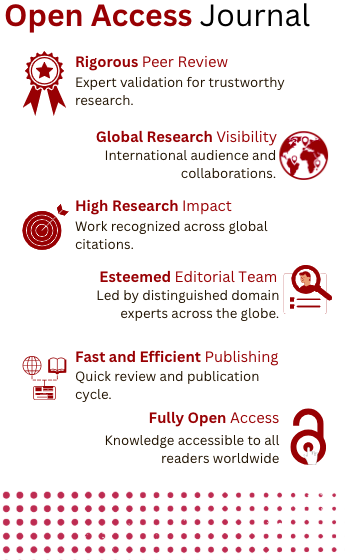Internet of Things (IoT) and Cloud Enabled Tables
Keywords:
Hassle free experience, customer QR Code, managing, customer support, customer freedom experience, human errorsAbstract
The main objective of this paper is to build a hassle free experience for the customer by providing them with service of ordering food with the help of an QR Code. Managing all information related to the menu, orders, customer support and provides with a customer freedom experience and also avoids all kinds of human errors and misunderstandings between the customer and the management. The paper proposes a novel notation of being a smart restaurant which shows us the reduction of human work with the least possible human error and thus increases the work efficiency with a user-friendly approach. The work is made at an administrative end where there is a guaranteed administrative access only. The work is completed with the help of both software and hardware parts. Software of this work deals with JavaScript, Html, CSS as for the frontend and the backend deals with Mongo Db. Hardware part of the work deals with a printer to print the selected menus by the customer and technology used here is Raspberry Pi.
References
Patil, A., Kalani, R., Patil, B., Shinde, S., & Shedole, S. M. (2017). Smart Restaurant System Using Android. International Journal of Technical Research and Applications, 5(3).
Rajesh, M., Satya, G. P., & PV, V. P. R. (2015). E-Restaurant: Online Restaurant Management System for Android. International Journal & Magazine of Engineering, Technology, Management and Research, 2, 574-579.
Saratha, P., Uma, G. V., & Santhosh, B. (2017, February). Formal specification for online food ordering system using z language. In 2017 Second International Conference on Recent Trends and Challenges in Computational Models (ICRTCCM) (pp. 343-348). IEEE.
Moorhead, A., Bond, R., & Zheng, H. (2015, November). Smart food: Crowdsourcing of experts in nutrition and non-experts in identifying calories of meals using smartphone as a potential tool contributing to obesity prevention and management. In 2015 IEEE International Conference on Bioinformatics and Biomedicine (BIBM) (pp. 1777-1779). IEEE.
Ricky, M. Y. (2014). Mobile food ordering application using android os platform. In EPJ Web of Conferences (Vol. 68, p. 00041). EDP Sciences.
LK, S. S., Ahmed, S. T., Anitha, K., & Pushpa, M. K. (2021, November). COVID-19 Outbreak Based Coronary Heart Diseases (CHD) Prediction Using SVM and Risk Factor Validation. In 2021 Innovations in Power and Advanced Computing Technologies (i-PACT) (pp. 1-5). IEEE.
Rajesh, M. (2015). E-Restaurant: Online Restaurant Management. India: International Journal & Magazine of Engineering.
Bankar, A., & Suresh, S. S. (2015). Intelligent Restaurant-Menu Ordering System. IOSR journal of VLSI and Signal Processing, 5(5), 47-53.
Reddy, K. K., & Naresh, B. (2014). Intelligent E-restaurant using Android OS. Int. Jr. of Scientific Engg. and tech. research, 3(22), 4383-4385.
El Fiorenza, J. C., Chakraborty, A., Rishi, R., & Baghel, K. (2018, October). Smart Menu Card System. In 2018 3rd International Conference on Communication and Electronics Systems (ICCES) (pp. 847-849). IEEE.
Aguilar, E., Remeseiro, B., Bolaños, M., & Radeva, P. (2018). Grab, pay, and eat: Semantic food detection for smart restaurants. IEEE Transactions on Multimedia, 20(12), 3266-3275.
Ramaiah, N. S., & Ahmed, S. T. (2022). An IoT-Based Treatment Optimization and Priority Assignment Using Machine Learning. ECS Transactions, 107(1), 1487.
Aguilar, E., Remeseiro, B., Bolaños, M., & Radeva, P. (2018). Grab, pay, and eat: Semantic food detection for smart restaurants. IEEE Transactions on Multimedia, 20(12), 3266-3275.
Ravi, R. V., Amrutha, N. R., Amritha, E., Haneena, P., & Jaseena, T. (2019, January). An android based restaurant automation system with touch screen. In 2019 Third International Conference on Inventive Systems and Control (ICISC) (pp. 438-442). IEEE.
Syed Thouheed Ahmed, S., Sandhya, M., & Shankar, S. (2019). ICT’s role in building and understanding indian telemedicine environment: A study. In Information and communication technology for competitive strategies (pp. 391-397). Springer, Singapore.
Hidayat, M. M., Adityo, R. D., & Siswanto, A. (2020, February). Design of Restaurant Billing System (E Bill Resto) by Applying Synchronization of Data Billing in Branch Companies to Main Companies Based on Rest API. In 2020 International Conference on Smart Technology and Applications (ICoSTA) (pp. 1-5). IEEE.
Harpanahalli, J., Bhingradia, K., Jain, P., & Koti, J. (2020, March). Smart restaurant system using RFID technology. In 2020 Fourth International Conference on Computing Methodologies and Communication (ICCMC) (pp. 876-880). IEEE.
Ahmed, S. S. T., Thanuja, K., Guptha, N. S., & Narasimha, S. (2016, January). Telemedicine approach for remote patient monitoring system using smart phones with an economical hardware kit. In 2016 international conference on computing technologies and intelligent data engineering (ICCTIDE'16) (pp. 1-4). IEEE.
Downloads
Published
How to Cite
Issue
Section
License
Copyright (c) 2022 Meesala Shobha Rani, Nikitha Gajjala, Prathamesh Dasari, Ronit Chatterjee

This work is licensed under a Creative Commons Attribution-NonCommercial-NoDerivatives 4.0 International License.



